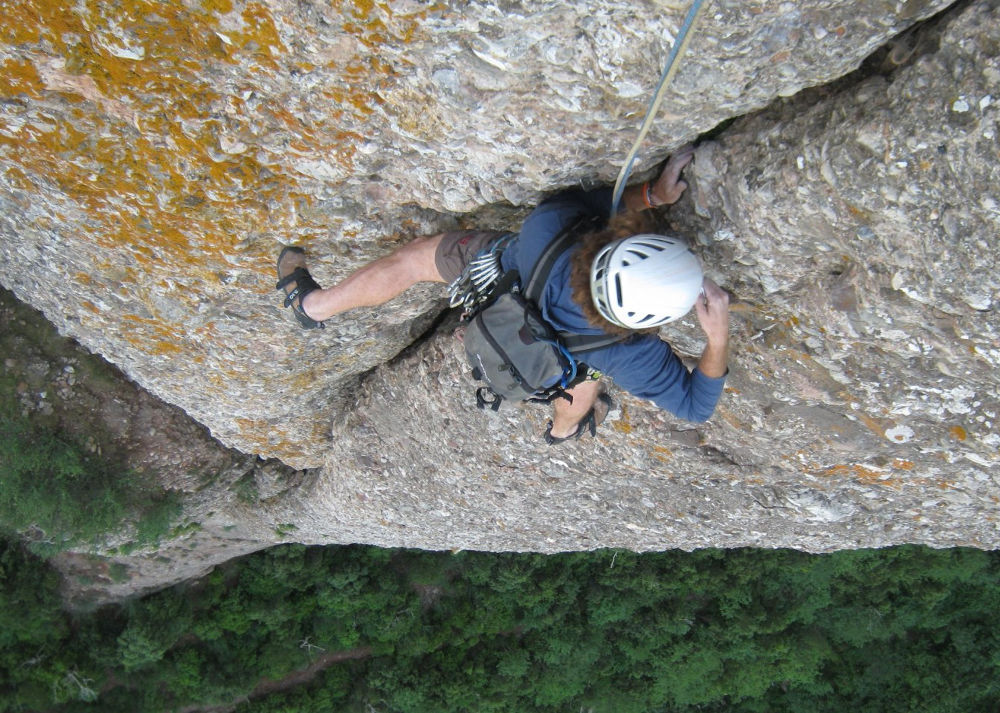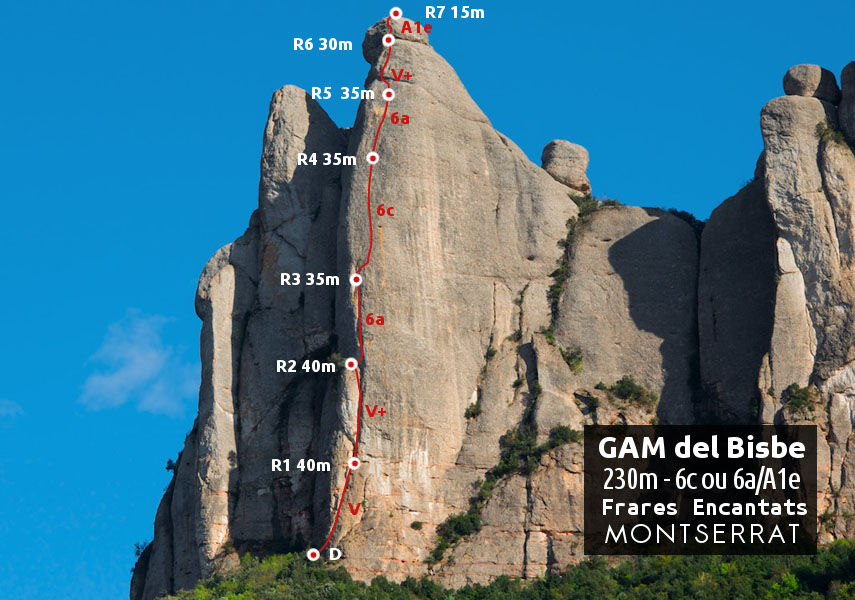




TOPO | CLIMBING7.COM
Publié le

Watch out for this Montserrat classic! Opened by the Groupe des escaladeurs de Alta Muntanya (GAM) in the 50s, this route is certainly worth its 5 stars despite the downside of uncertain equipment and slightly unstable rock on the first 2 pitches (although the route was re-equipped in 2008 by the Catalan federation). But the setting is splendid, on the north face of Montserrat, with the Pyrenees in the distance and several hundred meters of gas in the distance. Pitches 3 (6a) and 4 (6c) are magnificent, very well equipped for the occasion, and free climbing is possible without enormous difficulty (these passages are also equipped for A0 climbing). Lots of dihedral and cracks, a beautiful slab in the middle, one or 2 V+ bulges and even an A1e step at the very top to exit at the head of Bisbe. From here, an incredible view of the Agulles sector. It has to be said that the approach and return are not cheap, but in the end, it's a no-brainer. One of Montserrat's must-do routes.
❱❱ Technical summary
❱❱ Access to the place
From Barcelona, take the A2 towards Leida and exit Collbato at the last Bruc exit (at the Grand Hotel and before the tunnel). Turn right just after an abandoned petrol station, direction Manresa and Monsterrat. After a few hairpin bends, you reach the Col de Can Maçana at the westernmost point of the massif. Before crossing to the north, there's a parking area on the right.
❱❱ Map & topo

❱❱ Itinéraire
Take the GR 17 towards the monastery. Climb towards the west side of the Aguelles to the Col de Guirlo. Follow the GR northwards. Pass under the Cadireta, a huge ninja turtle head (yes, it is!) and a little further on fork right towards the Col de Porc. Further on, after winding up a small path, turn left to continue towards Col de Porc. The path passes under the aiguille du Bisbe and you can easily find a broken-down path that takes you to the base of the aiguille, where the route starts.
The route is 230m long in 7 pitches (40m, 40m, 35m, 35m, 35m, 30m, 15m). The equipment is uneven, inadequate in the first 2 pitches and very good thereafter, with a few quickdraws for the start and at least 20 quickdraws, plus 1 ladder if necessary (apparently not necessary).
L1 (40m, V)
Start along a characteristic crack on a slight diagonal. The points are quite far apart and the rock a little unstable. The end of the pitch is rather exposed. A medium friend may be needed for protection. The R1 belay is very comfortable, on a small flat spot next to a shrub.
L2 (40m, V+)
The most exposed pitch. Unprotected start to the dihedral. Entering the dihedral is tricky, with weathered rock for the feet and few clear handholds. The first point: an old nail! Above, you can secure yourself on a shrub, and then you really enter a long, vertical dihedral that's not easy at all. Fortunately, the parabolts come back at just the right moment. A step or 2 in the middle that could be worth a 6a. At the end, it's quite original: you have to enter a sort of chimney on the left and finish by climbing up in opposition to come out on a large rock next to the Bisbe, and all this without protection. Alternatively, go up the chimney on the left for greater safety. The R2 belay, on the other hand, is perfect. You can take out the barbecue without any problem.
L3 (35m, 6a or V+/A0)
From here on, the equipment is excellent. This pitch is molt bonic! It's a big, deep crack that forms a sort of dihedral. The holds are straightforward and you have to oscillate between the left and right walls to find the best option. Great atmosphere and great climbing! The R3 belay is at the exit of the crack on the left. The 35m doesn't seem to be there; I'd say it's more like 25m at most.
L4 (35m, 6c or V+/A0)
The longest route and for good reason. Exit straight above to reach a point equipped with a long rope that will allow you to branch off to the right towards the huge plate on the west side (without too much friction). What follows is superb, very homogeneous and continuous 6c, really accessible. Lots of balancing positions with tiny holds, but the rock is excellent and the feet hold on every scrape. Generous equipment that allows you not to scare yourself or to switch to A0. A very fine passage in the middle and another at the end just when you think you've finished... It's 35m long this time! Great atmosphere. The R4 relay, a little uncomfortable, literally suspended in the void.
L5 (35m, 6a)
An easier start to the belay with some nice potatoes, then it becomes vertical again and the level rises a little. An impressive right turn over a bulge with tiny cars at the bottom. The R5 relay is a few meters below a first panxa before the Bisbe head.
L6 (30m, V+)
Easy up to the panxa, which you know you have to watch out for. A fine, invigorating V+, especially with what we've left below. Then it's easy all the way to the belay, this time just below the (very small) Bisbe head.
L7 (15m, V/A1e)
Come on, what's left of your strength will get you there. 2 steps in artif' with a 3rd nail that's hard to carabineer. A0 then an easier exit to the summit. Phew, we've been up there for 5 hours, and I'm glad we made it!
I'm not sure we've taken the best option here! Recall the south face to find the ground in one go (45m I'd say). Then take the blue-marked path of the travessa dels Frares Encantats. It goes up and down, there are ropes to pull, rocks to roll, in short it's exhausting after all that effort. Anyway, after 30′ of walking and sweating, we finally land at the Col de Porc. Descend to the north to reach the foot of Bisbe, then take the approach path in the opposite direction. Alternatively, try the return via Les Agulles, which may take just as long but less.

Leave a Reply